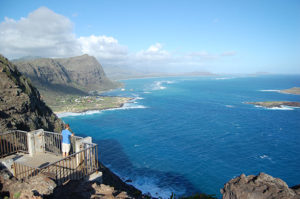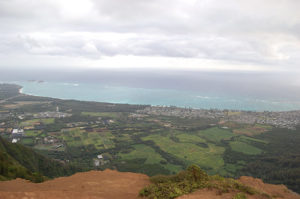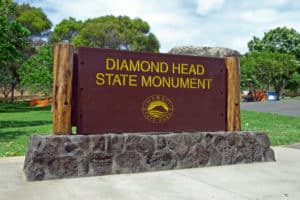Diamond Head State Monument’s iconic cliff faces—earning it the name Leahi, or brow of the tuna, in Native Hawaiian—tower over Waikiki, making this bustling state park an unmistakable part of the Oahu landscape.
Likewise, the Diamond Head hike is one of the most popular hikes and most visited state parks in the entire state of Hawaii, boasting a stunning shoreline view and a rich, varied history.
If you want to hike Diamond Head, you’ll want to get an early start to avoid the sunniest part of the day (the park opens at 6:00AM), but still hydrate, wear sensible shoes, and don’t underestimate the hiking trail—the 560-ft climb, including 175 stairs, over 1.6 miles roundtrip makes this a solid workout.
You’ll need reservations ($5pp) if you’re coming from out of state and there are fees for parking ($10/car). All in all, it usually takes 1.5-2 hours, leaving you with the whole day to still catch some of the nearby sites.
Table of Contents
The Hike
Budget 1.5-2 hours for this 1.6-mile (2.5 km) roundtrip hike. Much of the path is paved and there are lookouts and benches along the way to rest. However, the elevation gain to get to the top of the cone is significant, clocking in at 560 vertical feet from the crater floor to the overlook.
The steepest portions of the hike do have stairs (99 of them in the middle and then 76 at the very top of the hike), making it relatively straightforward and safe. But it’s still important to wear good shoes and drink plenty of water.
Although it tends to rain more often in the winter and be hotter in the summer, this is a great hike year round. Many hikers go in the early morning or late afternoon to avoid the hot Hawaiian sun as the only real shade on the switchbacks is to be found in a 225-foot tunnel near the summit.
Weekday mornings are the best time to go, though there are usually some people already lined up when the park opens at 6AM. And again, don’t underestimate how challenging hiking Diamond Head can be! Be sure to bring a hat, sunglasses, and sunscreen.
An audio hiking tour is available from the Visitor Center for $4—a good way to learn much of the geological, ecological, and historical significance of Diamond Head, including why Native Hawaiians considered the area sacred.
Some local tour guides and tour companies do offer guided hikes of Diamond Head and other nearby sites. A quick online search will also find you shuttles to the trailhead from Waikiki so you donʻt have to bother with parking.
Reservations
Head to the Division of State Parks website to make your reservation to hike Diamond Head if you’re carrying an out-of-state ID. Reservations are available 365 days a year and cost $5 per non-Hawaii resident.
Children under three and Hawaii residents (with a Hawaii ID or driver’s license) enter for free. Itʻs recommended to book your reservation at least a week in advance to make sure you have access to the times you want.
Parking at Diamond Head State Monument can be challenging and there’s an additional $10 per vehicle parking charge inside the crater, so you might consider getting there by bus, shuttle, trolley, taxi or rideshare, instead.
On days when the parking lot is full, it’s also possible to park on Diamond Head Road and walk the 5-10 minutes to the crater. Arriving before 9AM or after 2PM is recommended to help make sure you can find a spot.
Gates open at 6AM and close at 6PM. The latest you can head up on the trail, however, is 4:00PM.
Directions
Driving from Waikiki:
- Head southeast on Kalakaua Ave toward Uluniu Ave – 0.3 mi
- Turn left onto Kapahulu Ave – 0.6 mi
- Turn right onto Castle St – 0.3 mi
- Turn right onto 6th Ave – 246 ft
- Continue onto Alohea Ave – 0.6 mi
- Turn right onto Makapuu Ave – 272 ft
- Turn left onto Diamond Head Rd – 0.3 mi
- Turn right – 0.3 mi
- Continue onto Diamond Head Tunnel – 0.3 mi
- Turn left
By bus:
The 23 bus on Kuhio Avenue will take you to the Diamond Head State Monument bus stop. From there, it’s a 10-minute walk to get to the start of the trail. Visit the Bus site for up-to-date fares and schedules.
Diamond Head’s Natural, Historical, & Cultural Significance
The Diamond Head crater was created around 300,000 years ago by a single eruption, part of the Koolau Range of volcanoes that began on the sea floor more than 2.6 million years ago.
The crater floor encompasses 350 acres and its peak stands at an elevation of 762 feet above sea level (though it’s only 560 feet from the crater floor to the overlook).
The saucer-shaped crater was formed by an explosive eruption that sent ash and fine particles flying into the air. As they settled, these materials formed a kind of rock called tuff, which created the crater and can be seen all around it.
Most of the vegetation and birds of the area were introduced in the late 1800s to early 1900s. A stunning view of the shoreline from Koko Head to Waianae is visible from the summit and, during the winter, passing humpback whales can also be seen.
Diamond Head’s Native Hawaiian name, Leahi, means “brow of the tuna” and refers to the iconic profile of the crater’s outer slopes. The name Diamond Head came from 19th century British sailors who mistook the shiny calcite crystals on the crater’s slopes for diamonds.
In 1905, the US Government purchased Diamond Head and some of the surrounding areas, developing 720 acres into Fort Ruger as part of Oahu’s coast artillery defense.
As the US’s first military reservation, the site has hosted tunnels, batteries, anti-aircraft weapons, a National Guard emergency operations center, and the Hawaii State Civil Defense Headquarters. Some of these installations still remain today, including the Fire Control Station built in 1911, which follows the 225-foot tunnel near the summit. At the summit, you’ll also see bunkers and a huge navigation lighthouse built in 1917.
Things To Do Nearby
Several food trucks serve snacks and cold drinks 6AM to 4PM by the Visitor Center, but you may want to save your appetite for one of the great local eateries like Rainbow Drive-In, Ono Seafood, Tonkatsu Tamafuji, Tokkuri Tei, Guava Smoked, and Side Street Inn on nearby Kapahulu Avenue.
Even closer, Monsarrat Avenue boasts a bunch of good restaurants, including Pioneer Saloon, Cafe Moreyʻs, and the Diamond Head Market & Grill. On Tuesday and Saturday mornings, you can also catch the Kapiolani Community College Farmer’s Market right behind Diamond Head.
If you still have energy for walking and seeing the sights, then head over to Kapiolani Regional Park, where you’ll find plenty of picnic tables and local families. Waikiki Aquarium and the Honolulu Zoo are close by, as are Kuhio Beach and Waikiki Beach.








